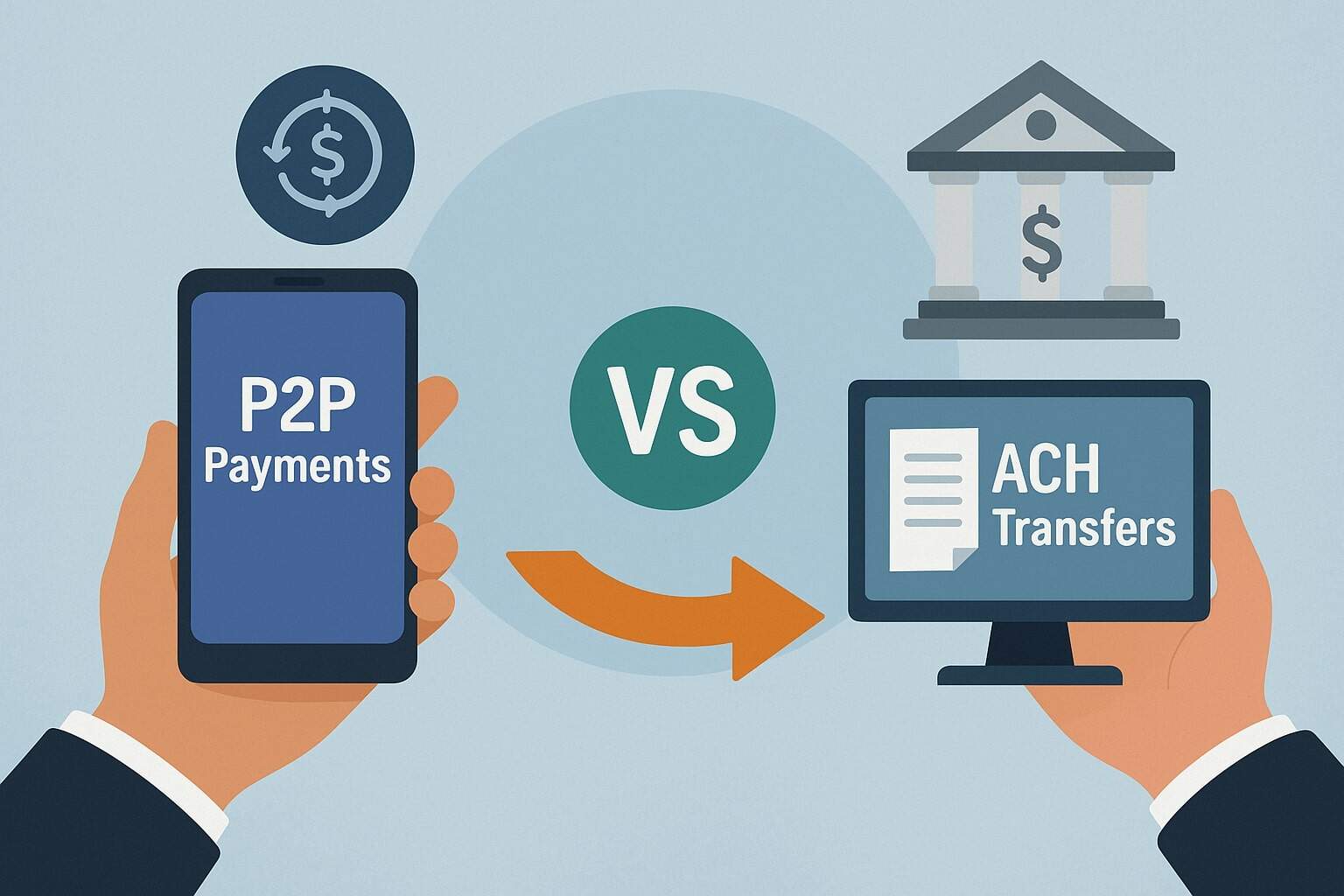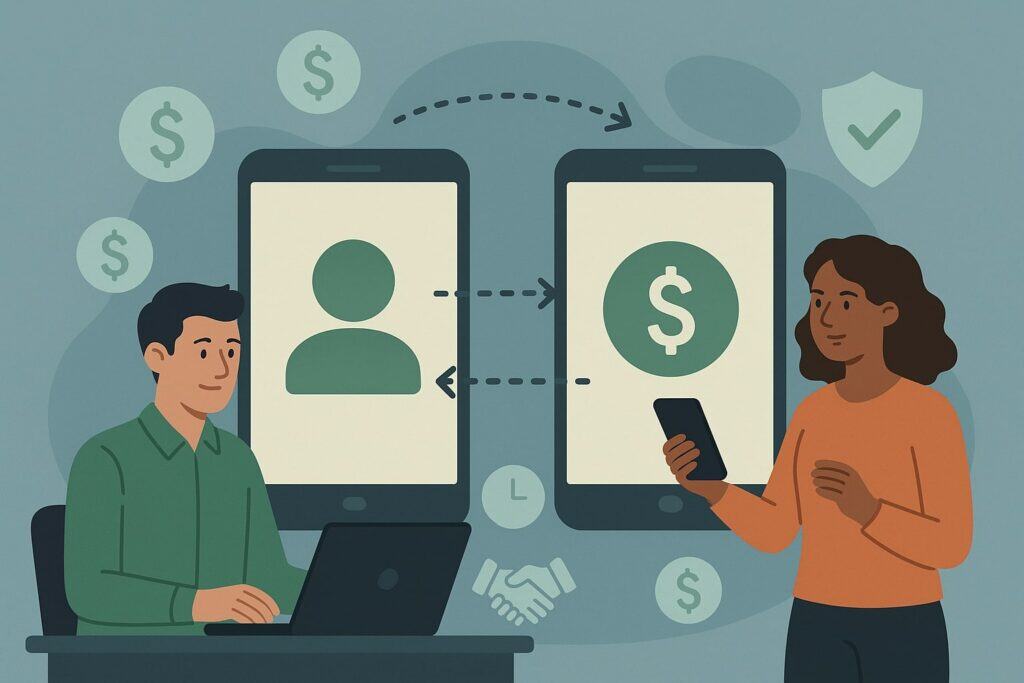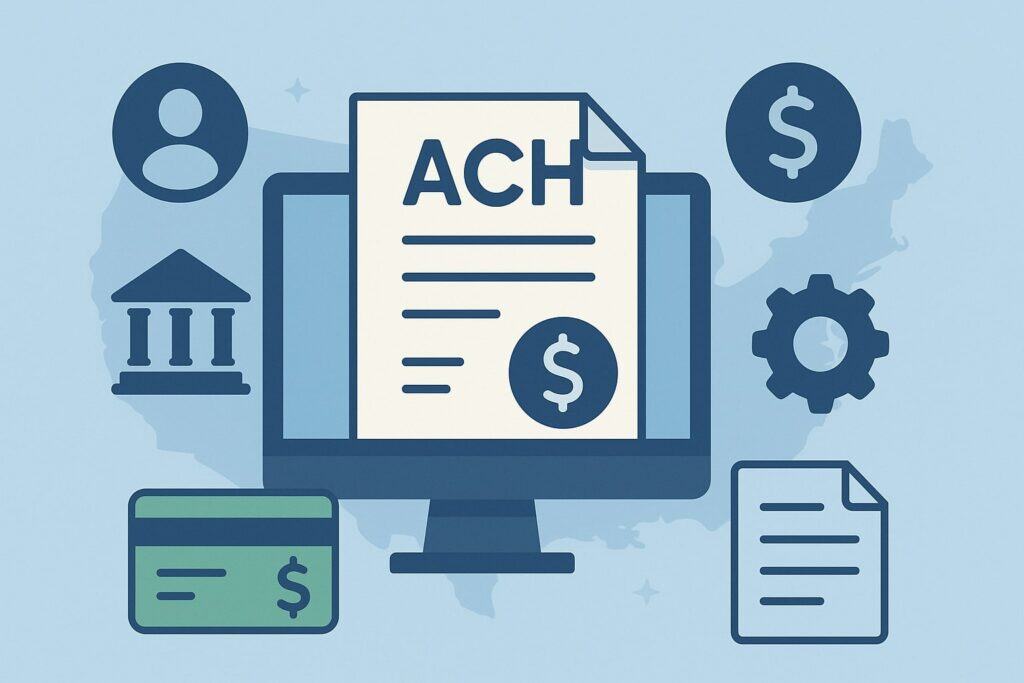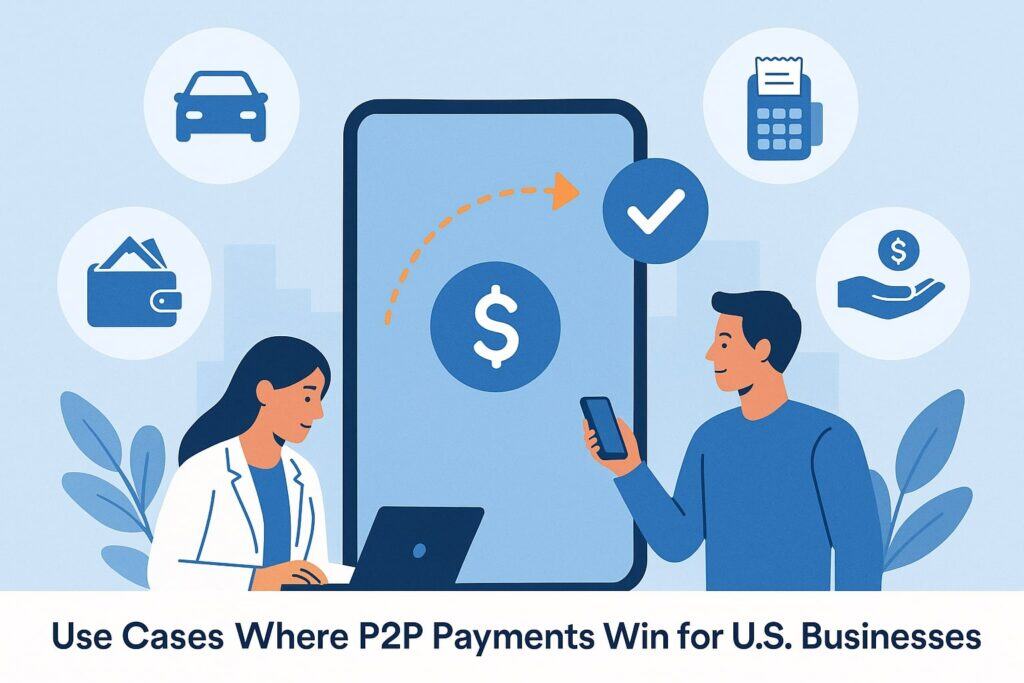
P2P Payments vs ACH Transfers: Which Is Better for Your Business?
P2P payments and ACH transfers both move money electronically in the U.S., but they do so in very different ways. If you run a small business, a growing startup, or an established company, choosing between P2P payments and ACH transfers affects your cash flow, fees, customer experience, reconciliation, and risk.
This guide explains how P2P payments compare to ACH transfers in plain language so you can make confident, compliant decisions. You’ll learn how each method works, how fast funds arrive, what each one costs, where fraud typically happens, and how U.S. rules apply.
By the end, you’ll have a practical framework to decide whether P2P payments, ACH transfers, or a thoughtful mix of both is right for your business today.
What Are P2P Payments—and How Do They Work for a Business?

P2P payments—short for peer-to-peer payments—let people send money to each other using mobile apps and digital wallets. In the U.S., common P2P payments apps include options that let customers pay quickly from a bank account, debit card, or wallet balance.
For businesses, P2P payments feel like instant checkout: the customer enters a handle, scans a QR code, or taps a link, and the payment is authorized within seconds. The app records the transfer and updates both users’ balances.
Funds may appear right away in the business’s wallet balance, while bank deposits can be instant for a fee or take longer at standard speed. Because customers already trust these apps for personal transfers, P2P payments often convert impulse purchases and speed up on-site checkout at pop-ups, farmers markets, and service appointments.
From a business perspective, P2P payments shine when you need convenience, low friction, and mobile-first experiences. You can accept P2P payments with simple setup, minimal hardware, and clear prompts on a phone screen.
The customer doesn’t need to hand over a card or type card details online. You get a payment confirmation nearly immediately, which is powerful in person. However, P2P payments live inside the provider’s ecosystem.
That means limits on monthly volume, transaction size, and certain business categories may apply. It also means policies for chargebacks, reversals, and seller protections vary by app.
As you compare P2P payments vs ACH transfers, think carefully about how much volume you’ll run, what record-keeping you need, and whether your customers already use the app you want to accept.
What Is ACH—and Why Do U.S. Businesses Rely on It?

ACH—short for Automated Clearing House—is the U.S. bank-to-bank rail that moves money in batches. ACH transfers power direct deposit payroll, bill payments, B2B invoices, and recurring subscriptions.
When you send or collect money via ACH, your payment processor or bank builds an electronic file and submits it through the ACH network. Receiving banks post credits or debits after the file settles. ACH has two primary speeds: standard ACH and faster same-day options, each with cut-off times.
Unlike P2P payments that primarily operate inside an app, ACH transfers settle bank-to-bank and integrate cleanly with accounting, treasury workflows, and enterprise approvals. If you issue payroll, collect retainers, or invoice corporate customers, ACH transfers are often the default.
ACH transfers are typically low cost per transaction, especially for larger amounts. You’ll see flat fees or small percentages that are materially lower than card interchange. ACH supports robust formats and return codes, helps automate reconciliation, and scales well for predictable, repeat payments.
You also choose from SEC codes tailored to use cases, such as WEB for online debits or CCD/CTX for corporate payments. Yet ACH is not always real-time, so you plan around cut-offs and settlement windows. ACH returns—like NSF (insufficient funds) or unauthorized debits—require monitoring and remediation.
If you’re comparing P2P payments vs ACH transfers, remember that ACH is built for reliability, controls, and scale, while P2P payments lead with convenience and speed at the point of interaction.
Speed, Cost, and Risk: The Core Differences That Matter
When choosing P2P payments vs ACH transfers, start with speed, cost, and risk. P2P payments feel instant to the buyer and often to the seller inside the app. That’s ideal for in-person service calls, event booths, and last-minute purchases.
If you need funds in your bank account immediately, some apps offer instant payout for a small fee; otherwise, you’ll wait for a standard transfer. ACH transfers run on bank rails with cut-offs and clearing windows.
Same-day options accelerate funding, but you still align with submission deadlines. ACH is not designed for impulse speed; it is designed for reliable settlement behind the scenes.
On cost, P2P payments may charge a percentage, a fixed fee, or tiered pricing for instant withdrawals. Fees vary by provider and by the instrument used—bank, debit, or wallet. ACH transfers usually cost less per dollar moved, particularly for B2B invoices and payroll.
When average ticket size is high, ACH cost efficiency compounds. On risk, P2P payments reduce card-present exposure and can minimize chargeback complexity compared to card rails, but they introduce policy-driven disputes inside a single app ecosystem.
ACH risk concentrates around returns, unauthorized debits, and compliance with NACHA rules. With good onboarding, account validation, and monitoring, ACH risk is highly manageable.
The right answer often blends both systems: P2P payments for fast, customer-friendly collection in the field, and ACH transfers for invoicing, recurring debits, and payouts that benefit from bank-to-bank reliability.
Use Cases Where P2P Payments Win for U.S. Businesses

P2P payments excel in face-to-face or mobile workflows where speed and convenience increase conversion. Think home services, personal trainers, tutors, repair techs, pop-up retailers, and food vendors at markets.
The fewer steps at checkout, the more likely the buyer pays on the spot. P2P payments also help in social commerce and community events, where customers already have the app on their phones.
For micro-merchants and side hustles, P2P payments can be a quick way to start accepting money before you set up a full merchant account. QR codes, pay links, and usernames make it simple to request the exact amount due.
When comparing P2P payments vs ACH transfers in these scenarios, P2P’s simplicity typically drives faster cash in and fewer abandoned payments.
Another strong use case is collecting deposits and tips. Customers respond well to a fast, familiar mobile prompt. P2P payments reduce awkwardness and make small payments feel casual and trusted.
That said, watch category restrictions and make sure your use aligns with the provider’s business terms. Confirm payout speeds and instant withdrawal fees so you’re not surprised.
Plan your record-keeping: export transactions regularly, tag activity by job or customer, and map P2P payouts to your books. If your customers are already heavy users of a particular app, leaning into that app can lift completion rates.
When P2P payments meet customers where they are, they become a powerful complement to ACH transfers you use for your larger, recurring, or invoice-based flows.
Use Cases Where ACH Transfers Are the Better Fit
ACH transfers dominate where predictability, scale, and accounting clarity matter most. If you issue payroll, collect retainers, draft monthly dues, or invoice other businesses, ACH is often the right choice.
The cost per transaction is typically low, which compounds for larger tickets and recurring billing. You can automate ACH debits on a schedule, reconcile with return codes, and maintain audit trails that satisfy finance and compliance teams.
For subscription software, professional services retainers, property management, healthcare billing, and education tuition plans, ACH transfers reduce churn from expired cards and lower your cost to collect.
If you need to send vendor payments or contractor payouts in bulk, ACH credits streamline your outgoing cash flow.
ACH also supports stronger pre-debit verification and account validation options, which helps reduce NSF returns and unauthorized disputes. With the right setup, you can verify ownership and account status before initiating debits, improving your success rate.
When you weigh P2P payments vs ACH transfers in a B2B context, buyer expectations tilt toward invoices and bank transfers, not consumer wallets. Your customers’ AP teams often prefer ACH because it fits their approvals and ERP systems.
ACH also handles higher transaction limits than typical P2P policies, making it suitable for five-figure or six-figure invoices. If your brand depends on professional billing and clean audit trails, ACH transfers deliver the discipline your finance team expects.
Compliance, Rules, and U.S. Tax Considerations to Keep in View
Every business accepting electronic payments must operate within U.S. rules. For P2P payments, review your provider’s business terms and seller policies. Understand your eligibility, restricted categories, dispute windows, and chargeback handling.
Confirm how the app treats refunds, partial refunds, and reversals. For ACH transfers, NACHA operating rules govern origination, returns, reversals, and formatting. Your processor should help you pick the right SEC codes and pre-debit authorization language for online or recurring debits.
Use account validation and fraud controls your provider offers; they are not optional for a healthy program. When comparing P2P payments vs ACH transfers, you’re also comparing policy environments—app-specific policies versus bank-network rules—so align with both.
On taxes, keep tight records for both P2P payments and ACH transfers. Export transactions, categorize revenue, and reconcile payouts to your bank. Payment platforms may issue information returns if your activity meets federal or state thresholds.
Thresholds and reporting rules can change, so verify current IRS and state guidance with your tax advisor before filing. Separately track sales tax where applicable and ensure your checkout method collects required details like billing addresses if needed.
Good bookkeeping eliminates headaches and strengthens your audit position. Whether you favor P2P payments or ACH transfers, organize your documentation monthly so you’re never scrambling at year-end.
Fees and Pricing: What to Expect and How to Negotiate
Pricing is a major factor in the P2P payments vs ACH transfers decision. P2P payments often charge a percentage for commercial activity, sometimes with additional fees for instant withdrawal to a bank account.
Some providers offer discounted pricing for bank-funded transfers compared to card-funded payments. Because P2P payments bundle the consumer experience, you’re paying for conversion and convenience.
For ACH transfers, pricing is usually a small flat fee per transaction or a lower percentage than cards. Same-day ACH may cost slightly more than standard, and account validation may carry a modest per-check fee. For large volumes, ask about tiered or subscription pricing that lowers your average cost as you scale.
To optimize costs, map your payment types. Route high-ticket, recurring, or B2B invoices over ACH to capture savings. Use P2P payments for low-ticket, impulse, or on-site payments where speed increases revenue.
Avoid paying for instant payouts unless cash flow truly demands it; otherwise use standard settlements to save. Negotiate with providers based on your mix, chargeback rates, average ticket, and projected volumes.
Ask for clear statements that break out fees, returns, refunds, and optional services like validation. Your goal is transparency: once you can see the drivers, you can shift transactions to the most cost-effective rail without harming the customer experience.
Security, Fraud, and Dispute Handling Across Both Rails
Security and fraud prevention differ between P2P payments and ACH transfers. P2P payments reduce exposure to card skimming and keying errors because customers approve inside their own app.
Multi-factor authentication and device intelligence help stop unauthorized access. Still, your business must guard against social engineering—fake handles, spoofed QR codes, or impostor invoices. Always verify recipient details and lock down your displayed usernames.
For ACH transfers, fraud risk centers on unauthorized debits, account takeover, and insufficient funds. Use account validation, micro-deposits or instant bank-linking, and velocity checks.
Monitor return codes to spot patterns, and quickly update billing when you receive R01 (insufficient funds) or R10 (unauthorized) returns.
Disputes work differently. In many P2P ecosystems, buyers initiate disputes within the app and policy rules dictate outcomes. Provide clear receipts, service documentation, and cancellation terms so you can respond.
For ACH debits, consumers have defined windows to claim unauthorized transactions under U.S. banking rules, while business-to-business debits follow different timelines. Keep signed or logged authorization records for online debits and recurring payments.
Whether you favor P2P payments or ACH transfers, publish a clear refund policy, honor it consistently, and store evidence of delivery or service completion. The less ambiguity you leave, the fewer losses you’ll absorb.
Implementation Guide: How to Add P2P Payments and ACH the Right Way
Implementation starts with requirements. List where you collect money (in person, online, on invoices), average and maximum ticket sizes, refund needs, and how fast you must access funds.
If your on-site teams struggle with failed cards or slow terminals, test P2P payments with QR codes and pay links. Train staff to confirm the business handle, amount, and payment confirmation screen before delivering goods or closing a work order.
Set a routine to export P2P transactions weekly and reconcile them against payouts. If you invoice customers or run subscriptions, set up ACH with your processor. Configure bank account verification, choose the right SEC codes, and add required authorization language to online forms.
Next, connect everything to your accounting system. Map P2P payouts and ACH settlements to distinct clearing accounts so reconciliation is clean. Automate webhooks or use scheduled exports if your tools don’t integrate natively.
Build exception queues for refunds, disputes, and ACH returns so your team resolves issues quickly. Finally, measure what matters: settlement times, fees by rail, dispute rates, and customer satisfaction.
Use that data to fine-tune routing rules—send the right payment to the right rail. When you approach implementation as a process, not a one-time setup, the P2P payments vs ACH transfers decision becomes dynamic and data-driven.
Decision Framework: Choosing Between P2P Payments and ACH
Use a simple framework to compare P2P payments vs ACH transfers for each flow:
- Speed needed: If immediate confirmation boosts conversion, P2P payments are strong. If the payment funds a scheduled invoice, ACH fits better.
- Ticket size: For larger tickets, ACH’s cost advantage usually wins. For small tickets, P2P convenience can outweigh fees.
- Customer context: Consumer buyers with phones in hand prefer P2P payments. Corporate AP teams prefer ACH invoices.
- Reconciliation: ACH integrates neatly with accounting for recurring and B2B flows. P2P needs extra tagging and export discipline.
- Risk posture: ACH with validation controls reduces returns over time; P2P reduces card-present exposure but relies on app policies.
- Cash flow: If you routinely pay for instant payouts, ACH might yield better net proceeds. If speed closes more sales, P2P might be net positive.
Score each flow across these factors. Many U.S. businesses land on a hybrid: P2P payments for fast, customer-friendly collection in person, and ACH transfers for recurring billing, payroll, vendor payments, and higher-value invoices.
Operational Checklist for U.S. Businesses
Use this checklist to operationalize your choice:
- Accept both rails where it helps. Offer P2P payments on mobile and in person; use ACH for invoices, subscriptions, and payouts.
- Publish clear terms. Post refund, cancellation, and dispute steps. Keep proof of delivery and service completion.
- Validate bank accounts. For ACH debits, use account verification and name matching to reduce returns.
- Standardize identifiers. Lock down your P2P handle, display it consistently, and use QR codes you control.
- Automate reconciliation. Map P2P payouts and ACH settlements to separate clearing accounts in your books.
- Monitor fees and timing. Track instant payout usage, same-day ACH costs, and average funding times.
- Train your team. Teach steps to confirm P2P receipts, handle ACH returns, and escalate disputes quickly.
- Review compliance annually. Re-check NACHA requirements, provider policies, and tax reporting rules each year.
- Route by rule. Send high-ticket or recurring payments to ACH; keep P2P for small, fast, or on-site transactions.
- Measure outcomes. Monitor conversion rates, dispute rates, DSO (days sales outstanding), and total cost to collect.
FAQs
Q1: Are P2P payments considered “instant” for businesses?
Answer: P2P payments usually confirm instantly inside the app, which helps you complete the sale. Bank withdrawal timing depends on whether you choose instant payout for a fee or standard transfer. Check your provider’s funding schedule and plan cash flow accordingly.
Q2: Are ACH transfers slow?
Answer: ACH isn’t real-time, but faster windows exist. Same-day options speed up settlement if you meet submission cut-offs. For predictable billing, ACH timing is reliable and integrates smoothly with accounting.
Q3: Which is cheaper—P2P payments or ACH?
Answer: For high-value or recurring payments, ACH is typically cheaper on a per-dollar basis. P2P payments can cost more but may lift conversion for small, on-site transactions. Model both against your average ticket and volume.
Q4: What about chargebacks and disputes?
Answer: P2P disputes run under the app’s policies. Keep clear receipts and service records. ACH disputes and returns follow banking rules and NACHA guidelines. Use strong authorizations and account validation to lower ACH return risk.
Q5: Can I accept P2P payments for B2B invoices?
Answer: You can, but many AP teams prefer ACH because it fits their processes and controls. Offer P2P as a backup or for deposits, and keep ACH as your primary rail for B2B settlement.
Q6: Do I need special terms to debit a customer via ACH?
Answer: Yes. Collect proper authorization language for one-time and recurring debits, store consent records, and select the correct SEC code through your processor.
Q7: Are P2P payments safe for larger amounts?
Answer: P2P payments are secure, but provider limits and policies may cap transaction sizes. For five-figure invoices, ACH is more appropriate and easier to reconcile.
Q8: How should I record P2P payments in accounting?
Answer: Create a clearing account for each payout source, tag transactions by customer or job, and reconcile weekly. Export reports from the app and match them to bank deposits.
Q9: Can I use both P2P and ACH at the same time?
Answer: Absolutely. Many U.S. businesses use P2P payments for speed in the field and ACH transfers for invoices, subscriptions, payroll, and vendor payments. Route by what optimizes cost, conversion, and controls.
Q10: What should I review for taxes?
Answer: Maintain accurate records for both rails. Confirm current IRS and state information-reporting thresholds with your tax advisor, and make sure your sales tax handling matches your products and locations.
Conclusion
The P2P payments vs ACH transfers debate isn’t about picking a single winner; it’s about selecting the right rail for each job. P2P payments deliver mobile convenience and near-instant confirmation that help you close sales on the spot.
ACH transfers deliver low cost, reliable settlement, and clean integration for invoices, subscriptions, payroll, and vendor payments. The most resilient strategy blends both. Accept P2P payments where speed and simplicity boost revenue.
Lean on ACH transfers where scale, cost efficiency, and accounting discipline matter most. Build clear policies, automate reconciliation, and monitor fees and timing. With that approach, you optimize cash flow, reduce friction for buyers, and keep your finance team happy—no matter how your business grows.